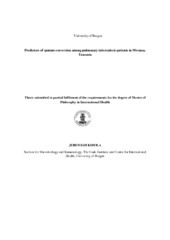Predictors of sputum conversion among pulimonary tuberculosis patients in Mwanza,Tanzania
Master thesis
Permanent lenke
https://hdl.handle.net/1956/3415Utgivelsesdato
2009-05-15Metadata
Vis full innførselSamlinger
Sammendrag
Tuberculosis (TB) is a major cause of morbidity and mortality worldwide. TB remains a burden especially in Africa, Eastern Mediterranean and South-East Asia regions. Tanzania ranks as number 14 globally and is the 6th in Africa. The number of TB cases in Tanzania has increased six folds in the past two decades. Seven percent of the population in Tanzania is infected with HIV and 50% of TB patients are co-infected with HIV. In addition, the majority of TB patients are malnourished. Because resources are limited, it is imperative to focus the efforts of the health system on those patients needing the most care. Lack of sputum conversion in pulmonary tuberculosis patients on anti-TB treatment is an indicator of potential treatment failure. These patients represent a source of continued TB transmission. Such patients may in the worst case turn out to be harbouring drug resistant Mycobacterium tuberculosis. Predicting treatment outcome in TB patients receiving anti-TB treatment at an early stage, by identifying factors among patients who are more likely to end up in treatment failure, would benefit the TB program overall. The aim of this study was to identify risk factors that may be associated with persistent sputum smear positivity at the end of the 2nd month after initiation of anti-TB treatment among pulmonary TB patients in Mwanza, Tanzania. Methods: A cohort study conducted within ongoing randomised multi-micronutrient supplementation trials among smear positive pulmonary TB patients in Mwanza city was undertaken from April 2006 to November 2008. All patients recruited were interviewed obtain social demographic and TB medical history. In addition, anthropometric measurements were recorded at baseline and at 2 months post anti-TB treatment. HIV counselling and testing were undertaken. Laboratory investigations were done . Results: A total of 601 PTB patients were enrolled of which 249 (41%) were HIV+. 516 (86%) patients were followed to the end of the 2nd month anti anti-TB treatment. The overall sputum smear conversion rate at the end of the 2nd month of the intensive phase was 76. 4%, while the sputum culture conversion rate was 94. 2%. Factors associated with persistence of sputum smear positivity at the end of the 2nd month of intensive phase were: male sex (OR 1.92, 95%CI 1.16; 3.18, P=0.01), 3+ initial pre-treatment AFB smear grading (OR 1.9, 95%CI 1.17; 3.19, P=0.01) and a BMI of < 18.5kg/m2 (OR 2.17, 95%CI 1.24; 3.7, P=0.006). The presence of a BCG scar was found to be associated with a 43% lower risk of persistence of sputum smear positivity at the end of the 2nd month after initiation of anti- TB treatment (OR 0.57, 95%CI 0.35;0.95, P=0.032). The presence of a BCG scar was also strongly associated with a lower risk of persistent sputum culture positivity (OR 0.28, 95%CI 0.35; 0.95, P=0.002). HIVstatus, smoking, CD4 count, total WBC count and Hb levels were not sassociated with sputum smear microscopy and sputum culture conversion post anti-TB treatment. Conclusion: Pulmonary TB patients with an absence of BCG scar, male sex, high initial AFB sputum grading, and a low body mass index, are at a risk of remaining culture and/or sputum smear positive at the end of 2nd month of the intensive phase of anti-TB treatment. Closer attention should be provided to such patients while on anti- TB treatment. Additionally, BCG vaccination should be continued to be promoted and supported. Larger studies also in other areas are needed to assess the role of BCG vaccination on sputum conversion
Utgiver
The University of BergenOpphavsrett
Copyright the author. All rights reservedThe author
